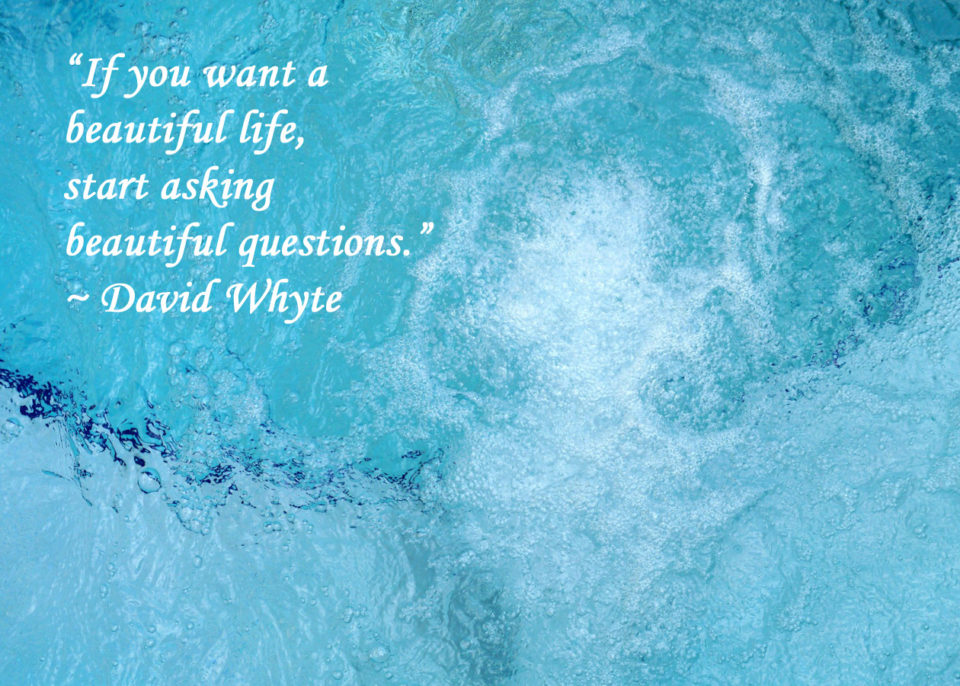
Last year, I spent a weekend with a friend at a retreat, where we experienced the wisdom and poetry of David Whyte. One line in particular from Whyte stuck with me.
If you want a beautiful life, start asking beautiful questions.
My friend and I talked about what this meant while driving home. We wondered, “what is a beautiful question, anyways?”
“A beautiful question is an ambitious yet actionable question that can begin to shift the way we perceive or think about something — and that might serve as a catalyst to bring about change.” ~ Warren, Berger, A More Beautiful Question
I like this definition by Berger, although he is coming from a place of asking questions to spark change in the workplace. However, the definition also applies when we want to bring about change in our lives or communities or relationships. A beautiful question is ambitious (challenging) and actionable (doable). It has the potential to shift our perceptions and bring about change.
A beautiful question is an adventure in seeing.
This is a theme I plan to explore this year. My friend and I are doing a project where each month we ask each other one beautiful question. Our answer can be in writing, poetry, photography, or some other art form. Over the holidays, when my family sat down to eat together, I brought a daily question to the table. I’m going to practice inserting beautiful questions into everyday conversations. These don’t have to be overly deep. David Whyte calls them invitations. They indicate a desire to know and understand someone better.
Sometimes our photographs reveal answers to questions of which we’re not yet conscious.
In the Facebook group for the Adventures in Seeing book, we’re asking ourselves this week what it means to be open. We’re looking for the answer by becoming aware of symbols of openness in our environment.
When I set out for a walk this week with this question in mind, I had no idea what would come up. While the ground was bare the day before, now it was covered with a light coating of snow. It was still morning, so there were areas still untouched by human (or other) presence. Other areas bore imprints of boots, paws, or tires. I realized that being open was like a fresh coat of snow, just waiting to see what will be imprinted next. That is the way I feel about this year, that I need to remain open to unknown possibilities or events. I remember attending a workshop with Freeman Patterson, where he told a story about becoming euphoric after photographing a field of brown grasses with snow.
“Your art is always running two to five years ahead of your conscious awareness of it. So I realized that something was going on that I was probably going to become aware of. The longer I looked at that field, the more I thought that I’m looking at an important symbol of my life at this point. I’ve traveled all over the world; been on all the continents. I’ve got wonderful friendships. I’ve had all kinds of experiences, good, bad, and indifferent. And my life has come to be a lot like this field. All of these strands are interwoven. All of the tones are here. The field was functioning as a symbol of where I was at that point in my life, and photographing it had brought it to my conscious awareness. That’s why I was on such a high.” ~ Interview, Berman Graphics
We explore the themes that run through our photography in the visual journaling workshop, Once Upon a Time: Your Photographs have Stories to Tell. Registration is open.
How do you know which questions are being asked of you right now? David Whyte, in his poem, Sometimes, calls those the questions that “have no right to go away.” He invites us into the silence which allows our own questions to reveal themselves. Click on the image below to read the whole poem.
What question is being asked of you right now?
** Books mentioned have Amazon affiliate links, meaning I make a few cents if you purchase through my link. I only recommend books that I’ve read.
More Questions
David Whyte – with Oprah on 10 Questions that Have No Right to Go Away
Martha Beck – Questions that Could Change your Life
The New York Times – The 36 Questions that Lead to Love by Daniel Jones
I absolutely love the idea of “beautiful questions”, Kim. What a lovely idea to incorporate into one’s living! I know that I am the author of my book of life – what better than to make it beautiful!